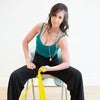Description
About This Video
Transcript
Read Full Transcript
I would like to discuss two to three fundamentals in the quadruped position that can shed some light on the exercise bird dog or opposite arm and hand opposite arm and leg reach and thread the needle. And those two exercises will have variations within them. So first, in this bird dog position, we need to understand that The pressing of the shins creates a connection to the hip. The pressing of the hands creates a connection in the shoulder. What happens sometimes when we press the hands is we get stuck in the elbow, and we make the elbow be the driver.
The elbow is not the driver. The hand pressing into the ground gives us information in the shoulder. So two arms pressing, two shins pressing. The next awareness I'd like you to make is when two hands drag in the direction of your two knees. That makes a little forced closure or a flexion connection in the front of your body.
Likewise, dragging your two knees in the direction of your hands will also create that connection. So just by doing that, you're creating a nice awareness in the front of your body. To advance this, I can turn the toes underneath pushing down into my hands and pulling them in the direction of my knees, and then I lift my knees up without changing anything else in my body. Then I get thigh information and more trunk information. Again, it looks like this.
The arms constantly pressing feed my shoulders. My shoulders support my chest being lifted. So when you push your arms down in the quadruped position, it would be much like pushing your arms forward in a kneeling position, and then quadruped becomes plank. Arms pressing down. Feeding the underside of the belly without resting in the elbows.
As a reminder, always pressing the hands to feed the shoulders. The elbows are not in a hyper extended position. The elbow creases roughly facing each other. Moving on. Opposite arm and leg reach.
So when we do this quadruped opposite arm and leg reach, this time, let's concentrate on the pieces that are down on the mat. So I'm gonna keep my left arm pressing down informing my shoulder, and I'm going to keep my right shin down informing my hip and then connecting through the front of my body. So then the two other pieces, the right arm here that I'm waving and the left leg, that now I'm going to press down as I raise. I just repositioned my head. Did you see that? Because if I start to lift my chin, that's gonna make my back arch. So I do not want that to happen.
I need to lift by pressing my arm, my head needs to be long, and that pulls my throat back. So this is an opposite arm leg reach, other side. Set up. The setup is everything. Press the right arm. Press the left leg.
Press the two pieces down. Make information in your body. Connect in with the head, neck, your your your throat is long. Right? Your eye gaze is down. Bewobbly.
It's okay. So creating opposite arm and leg reach with a stable trunk, the stability is kind of fed by the arms and the legs. If you are a person or you are somebody that wants to feed extension in this in this opposite arm and leg position, then we have to give it an extension moment. And what that means is I let my bottom stick out. I let my head lift.
And so now I am in, a lengthened abdominal, right, my low back is short. It's an extension. And I still press down on the opposite arm and leg, but this time my right arm is pushing away from me. It's not moving, but it's pushing away. And then I'm going to feed I'm gonna point my finger because I like to do that.
I'm gonna reach away, and now I'm feeding extension. And then I come to level. I'm in a reach, push this arm away, creating extension force, never sagging in that arm, reaching away extension. So choose which bird dog you wanna do. So what I what I mean by that is sometimes we think we wanna create some spine stability and balance but yet we end up doing a bird dog that has so much extension.
So we wanna play with that. Then you can create, the bird dog challenge by going from flexion to extension or from extension to flexion, it would look like this. So make your desire known, either to yourself when you're doing it, or if you're teaching a class or helping somebody else learn, is that you know which way would drive extension and which way would drive. Flexion. So in rotation, which is thread the needle, which is the other exercise I'd like to go over with you, the arms are always pressing.
So when the arms press the floor, the floor presses the arms, and then we give nice feedback to the shoulder blade and the rib cage. I've been asked a couple of times recently about how we build this rotation in our body, and, you know, some people have tightness in their mid back, tightness between their shoulder blades, and we cannot underestimate the power of the breath and movement in that area. So here's my version of thread the needle, meaning when you dive one arm under. So in this quadruped position, two arms pressing, two shins pressing. Right? This is what it would look like if I was resting in my hands and and my wrists hurt and everything like this.
Can you see that that is just, a flailed resting position? So just by cleaning this up, You can just see that that's a much more tidied up position where everything is engaged. And engaged does not mean gripped. It just means available for support. So I'm gonna take my right arm. I'm gonna start to thread the needle, and this left shoulder blade by way of this arm is always pressing.
So my rib cage here on this left side is scooching underneath my shoulder blade. This blade is way on the outside of my body, and my blades are going underneath it. If I wanna bend my elbow, I can, but I really want you to keep that elbow straight, get the arm really, really, really rotate, and then come back other side. Pressing down on this right arm, taking my left arm, and diving underneath it. So these these back ribs way over here on my right side are coming up as I go around and rotate.
My my right arm is pressing like mad. My left leg is pressing like mad, and I'm twisting. The arm is constantly pressing. So that's really needed if we progress that into some type of plank arm lift. So let's vary this last exercise in this little tutorial here about what the arms are doing, and let's go back and educate The difference between this so this is a shoulder blade motion, shoulder blades together, shoulder blades apart versus a spine motion, right, which is rib cage and spine lift. This is a blade motion.
So we want these blades to be in a a state of press if we're gonna do anything with balance or coordination in this action. So in this quadruped position, we can do tap, tap. Right? And then I can start to get to a more of a plank, tap tap, right, then I can curl my toes, engage, right, separate my legs for a little bit of balance, tap, tap. So it's never a rest into the shoulders that makes a sag, but it's always a press into the arms that gives us this upper body support.
Tips for Teachers: Keep It Fresh! Exercise Tutorials
Comments
You need to be a subscriber to post a comment.
Please Log In or Create an Account to start your free trial.
















